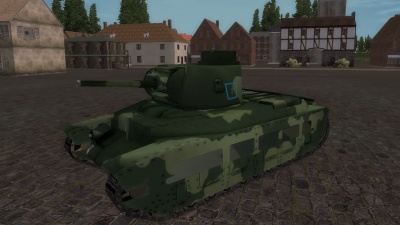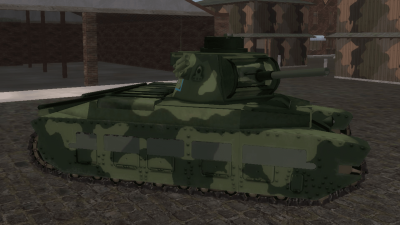Matilda
Infantry Tank Mk II (A12) "Matilda I"
History
| 400px | |
| Main Gun Optics | |
| Specifications | |
| Designation | No. 33 Mk. IV S. |
| Magnification | 1.9x |
| Field of View | 21° |
The “Matilda Senior”, as it was unofficially known, originated from a September 1936 Mechanisation Board proposal drafted for a more powerful and faster version of the Infantry Tank Mk I (A11) "Matilda I". The new tank would carry one more crewman, for a total of three, and be armed with either twin coaxial Vickers machine guns or a 2pdr Royal Ordnance Quick Firing (ROQF) anti-tank gun in a revolving turret. It needed to reach a speed of 15 mph (24 km/h) and its weight was limited to 14 long tons to meet current bridging restrictions.
The twin Vickers configuration was quickly discarded in favour of a 2pdr, at that time one of the most lethal anti-tank guns in the world, supplemented with a single coaxial machine gun. The A7 medium tank, which had been designed and manufactured by the Royal Ordnance Factory, Woolwich in 1929, was chosen as the basis of the new vehicle. To incorporate the change of armament and the selected layout into the design, the Mechanisation Board drew up a completely new specification that added 60 mm of armour, commercial diesel engines, and an additional crew member. The “Japanese” suspension, so called because it was based upon the Vickers Medium C tank sold to Japan in 1928, was to be protected by heavy side skirts. This new vehicle, the Infantry Tank Mk II (A12), was to be called the Matilda I, confusing at the time and even now, for this was the same name given to the previous A11 vehicle.
The Vulcan Foundary at Newton-le-Willows, Warrington, was awarded a contract in November 1936 to provide a wooden mock-up along with two mild-steel prototypes that were given the General Staff specification A12. The Mechanisation Board inspected the wooden mock-up of the vehicle in April 1937 and decided at that time to fit the tank with twin AEC London bus diesel engines coupled with a six-speed Wilson epicyclic pre-selector gearbox. Delays in the delivery of the gearbox and other critical components held up manufacture of the first A12E1 prototype, which Vulcan Foundary did not deliver to the Mechanisation Experimental Establishment (MEE) until April 1938.
The Vulcan Foundary won an initial order for 140 examples in June 1938. In August, the British Army ordered another 40 from Ruston and Hornsby, of Lincoln. The Matilda I (A12) was manifestly difficult to mass-produce and by the outbreak of war in September 1939, there were only two in service with the British Army, although 23 would be issued to the 7th Royal Tank Regiment in France by May 1940.
A British Army tank battalion in 1940 consisted of 50 infantry tanks: three companies contained 16 vehicles each with two more assigned to battalion headquarters. The majority of tanks in both British Army tank battalions in France in May 1940 were A11s. When battle with the 7. Panzer-Division (Armoured Division) was eventually joined at Arras on May 21, 1940, the available Matilda I tanks (A12) distinguished themselves and proved absolutely invulnerable to 37mm PaK 35/36 anti-tank guns. The Matildas nearly started a panic in the German ranks until the resourceful General Rommel marshaled several 8.8cm FlaK 18 anti-aircraft guns from a nearby anti-aircraft battery. The FlaK 18s knocked out the Matildas at almost point-blank range. Only the 88 could reliably penetrate the sturdy armor of the Matilda I with any kind of assurance. As a main battle tank, the Matilda I had little to fear from contemporary enemy tanks.
During the summer of 1940, after the rescue of the BEF from the beaches of Dunkirk, the War Office decided to standardise tank secondary armament and introduced the British version of the Czech-designed air-cooled ZB 0.303in Besa machine gun onto production lines. The A12, with the Besa instead of the Vickers machine gun, along with a minor modification to the roof of the turret to allow for an extractor fan, became the Infantry Tank Mk IIA (A12), or Matilda II.
Almost as soon as this upgraded Matilda II began to roll off the production lines, the authorities began a search began for an alternative powerplant. Designers eventually chose a 427 cu-in (7.00-L) Leyland diesel engine for the tank. Manufacturers fitted these engines into the Matilda chassis thereafter and the tank was re-designated Infantry Tank Mk IIA* (A12), or Matilda III. The Infantry Tank Mk IIA** (A12) or Matilda IV introduced a rigid engine mounting, and the Infantry Tank Mk IIA*** (A12) or Matilda V added a Westinghouse air servo directly to the top of the transmission to aid gear changing.
The Matilda is best remembered for its important role in the early Western Desert campaigns. Dubbed the “Queen of the Desert” for its immunity to almost any Italian tank or anti-tank gun in North Africa, the Matilda reigned supreme until the Germans brought their 8.8-cm guns to Africa in mid-1941. The “88” was the first gun able to penetrate Matilda’s heavy armour at long range.
The small size of the Matilda’s turret and turret ring made it impossible to retrofit a 57mm 6pdr gun (although some marks did carry a larger, lower velocity howitzer) and so, starting in 1942, the Matilda declined in importance. It last saw action as a gun tank at the first Battle of El Alamein in July 1942.
Game Play
The Matilda is an interesting vehicle to play. A formidable heavy tank seemingly able to stop an entire German armored column in its tracks, the Matilda seduces the player with hints of invulnerability. Don’t believe it for a second. Yes, you are pretty much immune to all German tank guns at the outset - although probably not as immune as you should be, historically - but the long 75mm gun on later vehicles like the PzKpfw IV Ausf. G and the StuG III Ausf. G can penetrate you without great difficulty. The ever present Ju 87 dive bomber can take you out easily, and of course there is always the threat of a lethal 88 firing from so far away, you can barely see it. Well-studied enemy tankers know that your gun and tracks are your vulnerabilities, that an immobilized Matilda can’t press an attack, and that a Matilda with a disabled gun is little more than a bulldozer. Relying exclusively on your armor as if you are invulnerable will result in a sad waste of this excellent tank.
Play aggressively but smart – if you have friendly infantry advising of a tank contact, you can often drive right over there and take it out, but be alert for ambushes and open spaces where you can be attacked from the air as, like in most tanks, your rear deck armour is thin. If you get shot at, don’t panic immediately, your armor will allow you some time to assess the situation - but don’t just sit there as if you can’t be harmed, because all tanks can be killed. You don’t have much speed, but the Matilda is stable on the move and makes an excellent mobile gunnery platform. Since your tracks are vulnerable, like those of all tanks, make sure that when you stop, it’s behind low berms or in slight ditches that protect your tracks. Remember, you are not invulnerable, but pointing your gun at an enemy tank that can't do much to you and watching it panic can be quite satisfying.
Infantry Tank Mk II (A12) "Matilda II Close Support"
History
| 400px | |
| Main Gun Optics | |
| Specifications | |
| Designation | No. 33 Mk. IV S. |
| Magnification | 1.9x |
| Field of View | 21° |
The “Matilda Senior”, as it was unofficially known, originated from a September 1936 Mechanisation Board proposal drafted for a more powerful and faster version of the Infantry Tank Mk I (A11) "Matilda I". The new tank would carry one more crewman, for a total of three, and be armed with either twin coaxial Vickers machine guns or a 2pdr Royal Ordnance Quick Firing (ROQF) anti-tank gun in a revolving turret. It needed to reach a speed of 15 mph (24 km/h) and its weight was limited to 14 long tons to meet current bridging restrictions.
The twin Vickers configuration was quickly discarded in favour of a 2pdr, at that time one of the most lethal anti-tank guns in the world, supplemented with a single coaxial machine gun. The A7 medium tank, which had been designed and manufactured by the Royal Ordnance Factory, Woolwich in 1929, was chosen as the basis of the new vehicle. To incorporate the change of armament and the selected layout into the design, the Mechanisation Board drew up a completely new specification that added 60 mm of armour, commercial diesel engines, and an additional crew member. The “Japanese” suspension, so called because it was based upon the Vickers Medium C tank sold to Japan in 1928, was to be protected by heavy side skirts. This new vehicle, the Infantry Tank Mk II (A12), was to be called the Matilda I, confusing at the time and even now, for this was the same name given to the previous A11 vehicle.
The Infantry Tank Mk II (A12) "Matilda II Close Support" was equipped with a 3inch main gun and a 7.92mm machine gun. Their role was to provide support to infantry attacks and they where usually attached to HQ companies.
Game Play
The Matilda Close support is an interesting vehicle to play. A formidable heavy tank, the Matilda seduces the player with hints of invulnerability. Don’t believe it for a second. Yes, you are pretty much immune to all German tank guns at the outset - although probably not as immune as you should be, historically - but the long 75mm gun on later vehicles like the PzKpfw IV Ausf. G and the StuG III Ausf. G can penetrate you without great difficulty. The ever present Ju 87 dive bomber can take you out easily, and of course there is always the threat of a lethal 88 firing from so far away, you can barely see it. Well-studied enemy tankers know that your gun and tracks are your vulnerabilities, that an immobilized Matilda can’t press an attack, and that a Matilda with a disabled gun is little more than a bulldozer.
Play smart – remember that you main gun is not to take out enemy armour, don't go charging of into town, as you are only equipped with HE and smoke. This tank is best used to suppress a spawn cp, with its slow speed you will struggle to find the enemy FMS. Sit there and kill the enemy. On the offensive you can provide an effective smoke screen for friendly infantry and direct fire from your 3inch gun can prove effective against buildings.
Armor
| Location | Thickness | Angle |
|---|---|---|
| Hull front | 78 mm | 0° |
| Hull sides | 40 mm 25 mm |
0° 0° |
| Hull rear | 55 mm | 25° |
| Hull top | 13-20 mm | 90° |
| Superstructure front | 47 mm | 67° |
| Superstructure sides | 70 mm | 30° |
| Superstructure rear | x mm | y° |
| Superstructure top | 20 mm | 90° |
| Turret front | 75 mm | 11° |
| Turret sides | 75 mm | 0° |
| Turret rear | 75 mm | 0° |
| Turret top | 20 mm | 90° |
| Gun mantlet | x mm | y° |

